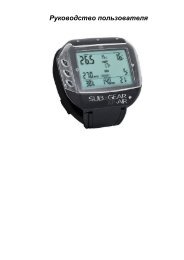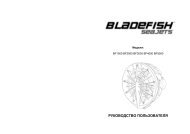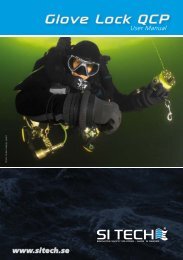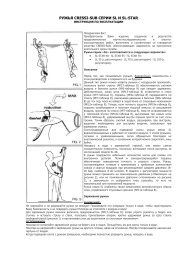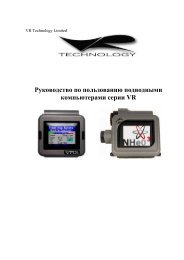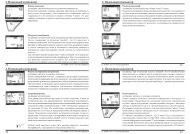Galileo SOL Manual - Scubapro
Galileo SOL Manual - Scubapro
Galileo SOL Manual - Scubapro
Create successful ePaper yourself
Turn your PDF publications into a flip-book with our unique Google optimized e-Paper software.
2. Menus, settings and functions<br />
With <strong>Galileo</strong> you can choose between<br />
workload (WL) estimation based on heart<br />
rate (HEART, default) or based on changes<br />
in the breathing pattern (RESPIRATION).<br />
You can also have <strong>Galileo</strong> always choose<br />
the highest between the two estimates<br />
(ALWAYS HIGHEST), the lowest between<br />
the two estimates (ALWAYS LOWEST) or<br />
you can turn it OFF completely. If you turn<br />
it OFF, <strong>Galileo</strong> will behave like an UWATEC<br />
Aladin PRIME dive computer.<br />
that as a reference. Any increase in breathing<br />
with respect to that initial pattern will be<br />
interpreted as an increase in workload.<br />
If you choose RESPIRATION or OFF, you<br />
can also choose whether you want to keep<br />
the heart rate monitor ON (to display the<br />
heart rate on the screen and to log it in the<br />
memory), or if you prefer to have it OFF.<br />
If you choose WL = HEART, you must<br />
personalize the algorithm adaptation by<br />
entering your maximum heart rate and your<br />
base heart rate while diving. If you do not<br />
know your maximum heart rate, a good<br />
approximation is given by subtracting your<br />
age (in years) from 220. For instance, a 35-<br />
year old would have a maximum heart rate<br />
of 185 beats per minute. To determine the<br />
base heart rate, use <strong>Galileo</strong> in its default<br />
setting on a relaxed, unstressed dive, then<br />
look up the average heart rate in the logbook<br />
(see section 2.12) or, better yet, download<br />
the dive to a PC using SmartTRAK<br />
(described in Chapter 4), then observe the<br />
heart rate profi le during the dive. For the<br />
example shown below, the base heart rate<br />
is approximately 100-110bpm.<br />
If WL is set to HEART or ALWAYS<br />
HIGHEST, the computer display will show<br />
HEART+ instead of just HEART. If WL is set<br />
to ALWAYS LOWEST, the computer display<br />
will show HEART- instead of just HEART.<br />
If WL is set to RESPIRATION or OFF and<br />
the heart rate monitor is set to OFF, the<br />
computer display will show HEART OFF.<br />
If WL is set to RESPIRATION or ALWAYS<br />
HIGHEST, the computer display will show the<br />
tank pressure with a + next to the unit (BAR+ or<br />
PSI+). If WL is set to ALWAYS LOWEST, the<br />
computer display will show the tank pressure<br />
with a – next to the unit (BAR- or PSI-).<br />
If <strong>Galileo</strong> detects a suffi cient increase in<br />
workload, no-stop times can suddenly<br />
shorten and decompression stops can quickly<br />
grow. To alert you of such possibility, upon<br />
entering into an increased workload situation,<br />
<strong>Galileo</strong> warns you with an audible sequence<br />
while displaying the message INCREASED<br />
WORKLOAD for 12 seconds. Unless you<br />
have selected WL = RESPIRATION, an<br />
INCREASED WORKLOAD situation is also<br />
signaled throughout its duration by the heart<br />
rate being displayed in inverted colors (white<br />
on a black background).<br />
If you choose WL = RESPIRATION, <strong>Galileo</strong><br />
will observe your breathing pattern during<br />
the fi rst two minutes of each dive, and use<br />
38



